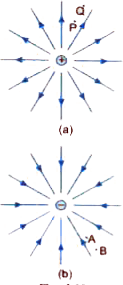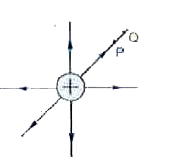Fig (a) and (b) show the field lines of a single positive and negative charges respectively .
Give the signs of the potential difference : VP−VQ,VB−VA

As electric field lines give the direction of electric field , which in turn is in the direction of falling potential , hence it is clear that VP>VQ or (VP0VQ) is +ve . Again VB>VA or (VB−VA) is positive .
Similar Questions
Figure (a) and (b) show the field lines of a positive and negative point charge respectively. (a) Give the signs of the potential difference . V_(p)-V_(Q), V_(B)-V_(A) (b) Give the sign of the potential energy difference if a small negative charge is moved from points Q to P from point A to B. (c) Give the sign of the work done by the field in moving a small positive charge from Q to P. ( d) Give the sign of the work done by the external agency in moving a samall negative charge from B to A . (e ) Does the kinetic energy of a small negative charge increase or decrease in going from B to A ?
View SolutionFigures (a) and (b) show the field lines of a positive and negative point charge respectively.

(a). Gives the sign of the potential difference VP−VQ:VB−VA
(b) Given the sign of the potential energy difference of a small negative charge between the points Q and P, A and b
(c) Give the sign of the work done by the field in moving a small positive charge from Q to P.
(d) Give the sign of the work done by external agencyin moving a small negative charge from B to A.
(e) Does the kinetic energy of a small negative charge increase or decrease in going from B to A?
View SolutionFigures 2.8 (a) and (b) show the field lines of a positive and negative point charge respectively. (a) Give the signs of the potential difference V_(P)-V_(Q): V_(B)-V_(A) . (b) Give the sign of the potential energy difference of a small negative charge between the points Q and P, A and B. (c) Give the sign of the work done by the field in moving a small positive charge from Q to P. (d) Give the sign of the work done by the external agency in moving a small negative charge from B to A. (e) Does the kinetic energy of a small negative charge increase or decrease in going from B to A?
View SolutionFigures 2.8 (a) and (b) show the field lines of a positive and negative point charge respectively. (a) Give the signs of the potential difference V_(P)-V_(Q): V_(B)-V_(A) . (b) Give the sign of the potential energy difference of a small negative charge between the points Q and P, A and B. (c) Give the sign of the work done by the field in moving a small positive charge from Q to P. (d) Give the sign of the work done by the external agency in moving a small negative charge from B to A. (e) Does the kinetic energy of a small negative charge increase or decrease in going from B to A?
View SolutionFigures (a) and (b) show the field lines of a positive and negative point charge respectively. (a) Give the signs of the potential difference V_(P)-V_(Q), V_(B)-V_(A) . (b) Give the sign of the potential energy difference of a small negative charge between the points Q and P, A and B. (c) Give the sign of the work done by the field in moving a small positive charge from Q to P. (d) Give the sign of the work done by the external agency in moving a small negative charge from B to A. (e) Does the kinetic energy of a small negative charge increase or decrease in going from B to A?
View SolutionFig (a) and (b) show the field lines of a single positive and negative charges respectively .
Give the sign of the potential energy difference of a small negative charge between the points Q and P , A and B .

View SolutionFig shows the electric field lines due to a point positive charge. P and Q are two point in the electric field.

i) What is the sign pf VP−VQ?
ii) What is the sign of the potential energy difference of a small negative charge between Q and P?
iii) What is the sign of work done by the field in moving a small positive charge from Q to P?
iv)What is the sign of work done by external agent in moving a positive charge from Q to P?
View Solution

